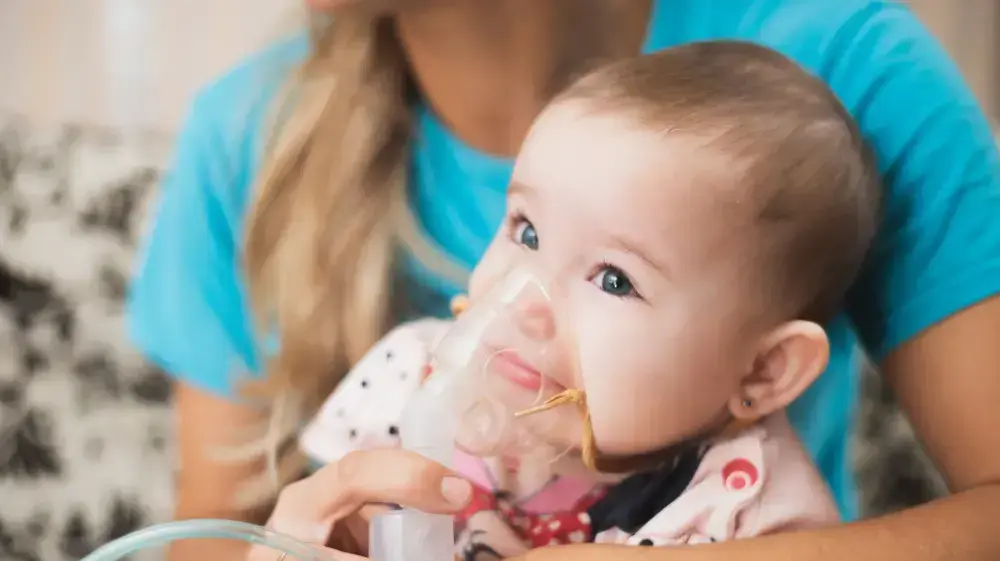It looks like a cold, but this disease can put babies at risk
RSV is a common cause of respiratory illness in infants. In fact, it is so common that it is almost indistinguishable from normal cold. However, it can become more complicated and dangerous in some cases. Here's everything you need to know
Upper respiratory tract infection, which may also reach the lower respiratory tract. Babies doing inhalation (Photo: shutterstock)
Mother inhales baby (Photo: ShutterStock)
At this time of winter, there is no child who does not suffer from runny nose and coughs. Most parents have already taken off the inhalers, have a seasonal amount of brine and calibrated the thermometer. While most winter diseases do not have much to do except try to relieve the symptoms and it is difficult to distinguish between the different viruses, there is one virus that is important to recognize its symptoms as it can cause complications.
More in Walla! NEWS More in Walla! NEWSThis will help children get through the winter with fewer illnesses
To the full articleRSV (or full name: Respiratory Syncytial Virus) is the most common cause of respiratory infections in children up to the age of two. The virus can cause upper respiratory infection (nose and muzzle), but also lower respiratory tract infection (airway and lungs). RSV is also the most common cause of bronchitis (bronchitis) and pneumonia in children under one year old. Among premature infants and infants with heart disease, there is a higher risk of complications and serious illness.
RSV is responsible for a quarter of hospitalizations for infants and toddlers because of pneumonia, and for nearly 75 percent of hospitalizations for bronchitis.
More in Walla! NEWS
Don't catch up: How long should you stay home after a winter illness? You and Phlegm: Why do children cough in the winter and how can they be relieved? How do you really snot dry your baby? What is the most effective way to remove stretch marks and firm the skin? Promoted ContentHow to identify RSV?
The main symptoms of RSV infection are not different from other viruses, and usually include runny nose, cough, wheezing and fever. In children and adults suffering from the asthma the virus can make the symptoms worse. RSV symptoms last an average of one to two weeks. After the infection, most of the treatment is designed to relieve the symptoms, such as lowering heat and analgesia.
Among infants and premature infants, the disease can manifest itself in apathy, restlessness, feeding difficulties and sometimes even respiratory distress. In severe cases, there may be a real difficulty in breathing, manifested by acceleration of breath and sighing of breath, and even as a window. In this case, it is important to get to the emergency room.
Is it dangerous?
But in previous winters there were reports in Israel of children dying from the virus, most of the RSV infections are not life-threatening and self-perpetuating. Mortality from the virus is uncommon, and is more typical for small babies and premature babies (babies born before the 36th week of pregnancy) whose respiratory system is more sensitive. For this reason, infants born until the 34th week of pregnancy are eligible for the first year of life (virus injection every month during the winter) and so are risk groups (children with lung and severe heart disease).
For high-risk premature babies, there is a dedicated vaccine. Baby in incubator (Photo: ShutterStock)
Premature babies (Photo: ShutterStock)
it's contagious?
is very. RSV virus spreads quickly and easily in children through coughing or sneezing, sharing of cups and other objects that have been in contact with the mouth and respiratory or eye secretions. The virus is highly contagious, even before the onset of symptoms, and can remain on surfaces for long hours. Maintaining good hygiene rules can reduce the risk of infection, yet - most children will get the virus up to the age of two, and parents just need to make sure it doesn't get worse.





